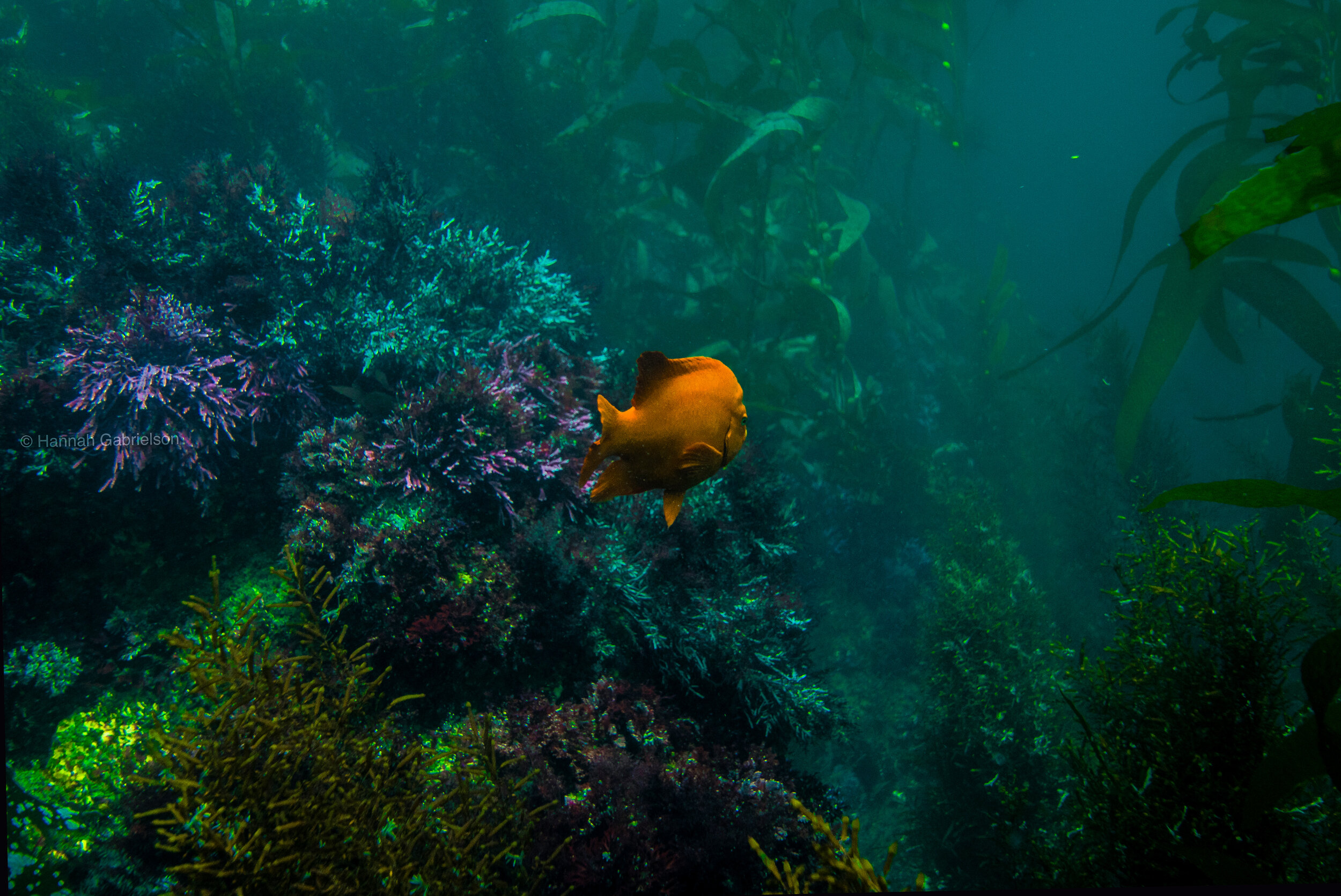Kelp Deforestation: Threats to our Underwater Forests
Words by Madison Churchill
Photos by Hannah Gabrielson
On Washington State’s Coast, thick matts of kelp can be found piled atop the water. Dipping beneath the surface, an entire underwater world unfolds. A rich ecosystem of green and red flows with the currents, with bull kelp that can reach hundreds of feet in some spots, connecting the surface to the ocean floor. These forests are vital. They face various threats, but with urgent intervention, we can preserve and restore these underwater forests that have dominated Salish Sea waters for milenia.
Kelp forests are some of the most dynamic and ecologically productive marine habitats in the world. A root-like system called a holdfast affixes to the rocky seafloor, supporting a long stipe that extends upward through the water column. A gas-filled bulb floats at the top, and tendrils extend outward throughout the stalk. The complexity of shape and structure provides habitat to various different marine species. These underwater forests are big producers of oxygen, and they help sequester carbon from the atmosphere. Undoubtedly, these ecosystems are very important to the health of our planet, but like much of our ocean, we’re at risk of losing them.
Giant kelp piles up on the surface. Photo: Hannah Gabrielson.
With great biodiversity, comes thousands and thousands of finely balanced species interactions. Loss of one or more species can put the entire system at risk of collapse. Kelp forest food webs are constantly being altered by loss of keystone or supporting species. On the West Coast of America, many of the giant kelp forests experienced massive collapse when the native sea otters were hunted near local extinction. Now, otters have slowly been returning, but we risk losing another important species.
Kelp forests provide vital habitat for marine life. Photo: Hannah Gabrielson.
Since 2013, the West Coast has experienced a massive loss of sea stars. Previously called Sea Star Wasting Disease, now just Sea Star Wasting or SSW, scientists are still unable to determine what is causing this disease, or if it’s even a disease at all. This condition impacts many different species of Echinoderms, and causes a curling and “melting” appearance of the sea star’s appendages. Within a matter of days, this will kill the animal. This dramatic loss of sea star population on the West Coast has caused a frightening chain reaction.
Like everything else in the ocean, sea stars fill a niche and provide a vital service to the ecosystem. One of their main prey, purple sea urchins, happen to have a voracious appetite for kelp and other seaweeds. Without sea stars to predate on the urchins, their numbers are growing unchecked. Urchins can move quickly through the seafloor, mowing down holdfasts and kelp stipes at an accelerated rate. They breed quickly, so a lack of predators can be deadly to the health of a kelp forest. This can create urchin barrens, which are essentially comparable to oceanic dead zones, where no kelp is able to survive. This can be lethal to the whole ecosystem and the numerous species it hosts: it essentially has the same effect as clearcutting a forest.
Urchins can quickly decimate a kelp forest, leaving urchin barrens. Photo: Hannah Gabrielson.
Unfortunately, urchins aren’t the only threat to kelp forests. Human activity like overfishing, pollution, and climate change can all create deadly obstacles for kelp forests. Freshwater runoff from agricultural spaces, or runoff including pesticides or other pollutants can be incredibly damaging to these fragile ecosystems. Rising water temperatures caused by climate change can prove impossible for marine species to adapt to, especially marine flora like algae and seaweeds. Marine macro-algae are incredibly sensitive to water temperatures, and are unable to evolve at the rate the seas are warming. Typically, kelp forests only survive in cold water, so these rising sea temperatures will eventually cause kelp forests to recede further and further north. Along with warmer water, climate change also brings harsher storms, which can be very destructive in these sensitive ecosystems.
Giant Kelp forests off the coast of California. Photo: Hannah Gabrielson.
Kelp forests provide astounding benefit to marine life as well as humans, and it’s important we work to conserve these critical habitats. Humans rely on kelp and other algae for over half of our oxygen, while it simultaneously sequesters carbon and slows the spread of climate change. These diverse and complex underwater ecosystems are key to the survival of our oceans. Organizations like Mission Blue have been setting out to place protections on kelp forest habitat. They recently named the Salish Sea as a Hope Spot they will be fighting to protect. Not only will this designation help kelp forests, but it will also protect our large marine species like orcas, whales, seals, and sea lions. Everything is deeply interconnected, so these marine sanctuaries are beneficial to numerous species, and the ecosystem as a whole.
Throughout the West Coast of the United States, many projects have been enacted to help restore kelp forests through various different methods including kelp planting, removal of invasive species, and reintroduction of key predators. These dense underwater forests are something we can’t afford to lose. We still have time to help protect them, but we must act quickly.
IF YOU’VE ENJOYED READING THIS ARTICLE FROM MADISON CHURCHILL, FOLLOW HER HERE @CHADISONMURCHILL AND LOOK OUT FOR MORE BLOG POSTS.
PHOTOS PROVIDED BY HANNAH GABRIELSON. FOLLOW HER HERE @HANNAH_GABRIELSON.
Want to write for us? Check out our ‘Get Involved’ section.




